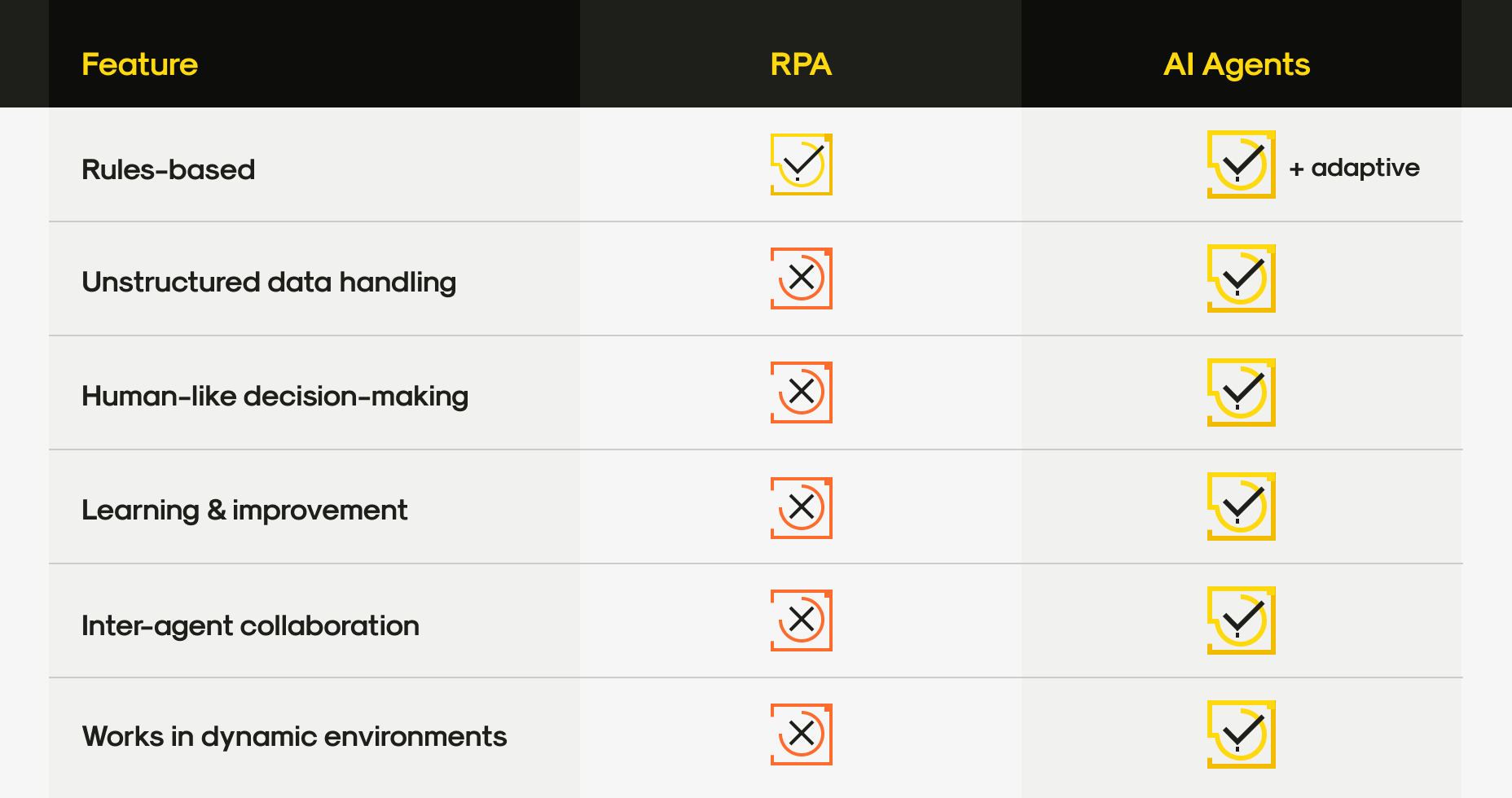For years, robotic process automation (RPA) has been the go-to solution for automating repetitive tasks. For instance, it’s been a valuable tool for handling copy-paste jobs, data transfers, and rules-based processes with efficiency. But RPA has its limits. It struggles with dynamic environments, lacks adaptability, and typically requires human intervention when workflows deviate from the script.
Enter AI agents, and these aren’t your average bots. They’re autonomous, context-aware, and increasingly capable of communicating and collaborating. The shift from one-off task bots to intelligent agent networks is the beginning of a new era in business process automation.
In this article, you’ll learn:
- Why traditional RPA tools are no longer enough for today’s dynamic business needs
- What AI agents are (and how they’re different from rule-based bots)
- How agent-to-agent collaboration enables real-time decision-making and self-orchestration
- Where AI agents can be deployed today, from customer service to supply chain operations
- The strategic business benefits of intelligent agent networks
- What it takes to successfully design, deploy, and scale AI agents in your organization
- And how Mitrix can help you build intelligent systems that do more than automate
What are AI agents?
AI agents are autonomous software entities that perceive their environment, make decisions, and act toward a goal. They’re built to learn, adapt, and operate in real-time. Think of them as digital co-workers who don’t just follow instructions: instead, they problem-solve, talk to each other, and adjust their behavior based on changing conditions.
Unlike RPA, which automates static tasks with predefined rules, AI agents can:
- Handle unstructured data (emails, documents, images)
- Make decisions based on context and goals
- Learn and improve over time
- Collaborate with other agents without human involvement
Let’s focus on agent-to-agent collaboration, a real game changer.
Agent-to-agent communication: a glimpse into the future
AI agent communication is the way artificial intelligence agents interact with each other, with humans, or with external systems to share information, make decisions, and carry out tasks. It’s a critical component in multi-agent systems, where agents collaborate, and in human-AI interactions, where smooth coordination is key to getting things done efficiently.
One of the most exciting developments is Google’s Multi-Agent Collaboration Prototype (MCP). In this system, multiple AI agents communicate to complete tasks without human prompting. Each agent has its own role, perspective, and partial understanding of a problem. They share knowledge, negotiate roles, and refine their strategies through communication.
For example, suppose a customer support query involves a refund, a shipping check, and a compliance check. In that case, different agents can handle each step, passing context-rich information to one another in real time. No need to escalate tickets or loop in a human for coordination.
This is more than smart automation. It’s the birth of self-orchestrating systems.
Why AI agents go where RPA can’t

RPA vs. AI agents feature comparison
Let’s break it down.
While RPA can automate repetitive processes (say, extracting invoice data from PDFs), AI agents can do that and adjust if the invoice layout changes, the currency fluctuates, or the business logic evolves.
In short, RPA automates tasks. AI agents automate thinking.
Real-world business applications
Let’s explore how businesses can leverage agent-based automation in 2025.
1. Customer support workflows
Imagine a network of AI agents working behind your customer support team:
- One reads the incoming query.
- Another accesses the CRM to pull customer data.
- A third checks relevant policies.
- A fourth drafts a personalized response.
They work in sync, hand off smoothly, and only escalate when truly necessary. Faster resolution, better personalization, fewer tickets.
2. Finance and procurement
AI agents can automate invoice validation, detect anomalies, and collaborate on approvals. One agent flags unusual patterns in spending; another recommends budget reallocations. All while ensuring compliance.
3. Sales ops and CRM hygiene
Unfortunately, data decay is real. In this regard, AI agents can monitor CRM entries, validate information via external sources (LinkedIn, emails), and update records without waiting for human prompts.
4. Logistics and supply chain
In complex logistics networks, AI agents can coordinate with each other to track shipments, reroute deliveries, manage vendor communications, and adapt in real-time to disruptions like weather or shortages.
5. HR and recruitment
Do you need to vet 500 resumes? One agent screens for skills, another checks social profiles, and another aligns candidates to open roles based on past hiring patterns. The result is astounding: a shortlist made in minutes.
Business benefits: beyond efficiency
This isn’t just about saving time, though that’s a nice perk. AI agents unlock entirely new capabilities:
- Scalability without linear cost. Adding more agents doesn’t mean hiring more people.
- Faster decision-making. Agents collaborate instantly. No waiting on email threads or approvals.
- Resilience. If one agent fails, others can pick up the slack.
- Intelligence amplification. Your team isn’t replaced, it’s augmented.
Instead of asking “How do we automate this task?”, businesses can ask: “How can we redesign the entire workflow for intelligence and adaptability?”
Building the agent network: what you need
While the technology is advancing fast, success with AI agent networks requires thoughtful design:
- Clear goals and success metrics. What are your agents trying to achieve?
- Data accessibility. Agents thrive on data. Make sure they can access systems and context.
- Secure communication protocols. Especially when agents pass sensitive information between systems.
- Fallback logic and human-in-the-loop. Some scenarios still need a human touch. Design graceful handoffs.
- Testing in sandbox environments. Let agents learn before going live.
You’ll also need to shift your mindset. Unlike RPA, which thrives in predictable rule-based worlds, AI agents work best when given objectives, not strict scripts.
From task automation to goal automation
This is the real revolution. Traditional RPA is about automating a button click. AI agents are about achieving outcomes. Let’s say your objective is to “shorten time-to-cash.” Instead of automating the invoice creation alone, an AI agent network can:
- Identify bottlenecks in the quote-to-cash process
- Prioritize deals based on payment history
- Nudge internal stakeholders or clients at the right time
- Escalate if delays are detected
You’re no longer managing tasks: you’re managing business goals with intelligent systems that learn and optimize along the way.
Getting started: your first steps toward AI agent adoption
You don’t need to overhaul your entire tech stack to get started with AI agents. The most effective transitions begin with small, high-impact wins that demonstrate clear value. Here’s how to move from theory to action:
1. Identify a high-friction process
Look for workflows where employees are bogged down by repetitive or decision-heavy tasks: customer inquiries, lead qualification, or internal ticket triaging are often prime candidates.
2. Start with one agent
You don’t need a full agent network from day one. Start with a single agent solving a specific problem. Think about getting a data-cleaning agent for your CRM or a response generator for basic customer queries.
3. Measure impact early
Define KPIs, like resolution time, employee hours saved, or NPS score improvement, and monitor changes after deployment. This builds internal momentum and executive buy-in.
4. Connect and scale
Once your first agent delivers results, it’s time to connect them. Add agents that collaborate and exchange data. This is where your system evolves into a true agent network, with emergent intelligence and self-orchestration.
5. Build for adaptability
Avoid hard-coded workflows. Instead, give agents goals, access to data, and the autonomy to figure out how to get there. That’s where the magic of real-time, context-aware automation kicks in.
Pro tip: Think of AI agents not as tools, but as new team members. They’ll need training, feedback, and the right environment to thrive (well, just like employees do). But once they’re up to speed, they don’t take vacations, work 24/7, and improve every day.
How we can help
At Mitrix, we build AI agents designed around your needs, whether you’re looking to boost customer support, unlock insights from data, or streamline operations. Let’s create a robust AI agent tailored to transform your business.
Customer support agents
Delivers 24/7 customer assistance, resolves inquiries efficiently, addresses issues, and enhances overall customer satisfaction.
Healthcare assistants
Performs preliminary symptom assessments, organizes patient records, and provides accurate medical information.
Financial advisors
Delivers tailored investment advice, monitors market trends, and creates personalized financial plans.
Sales agents
Identifies and qualifies leads, streamlines sales processes, and drives growth by strengthening the sales pipeline.
Data analysis agents
Processes and interprets large datasets, delivers actionable real-time insights, and aids in strategic decision-making.
Virtual assistants
Organizes schedules, manages tasks, and provides timely reminders to enhance productivity.
Our expertise across business domains enables us to develop AI solutions that are aligned with your business model and goals. From managing inquiries to delivering personalized experiences, our agents build stronger relationships while improving response times and satisfaction. We provide:
- Custom AI agent design and integration
- AI agent strategy consulting
- Task automation and optimization
- Security, compliance, and ongoing support
Contact us today to discuss your AI solution!
Summing up
In 2025, we’re entering an age where automation is no longer about robots doing repetitive work: it’s about intelligent agents collaborating toward shared outcomes.
If your business is still locked into rule-based bots, it might be time to rethink your strategy. The next leap in productivity, agility, and resilience lies in embracing agent-based automation networks. Again, you won’t just work just faster. You’ll work smarter, and that’s the thing.


